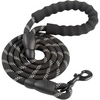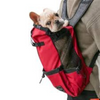Dogs are often considered members of the family, bringing great joy and companionship to our lives. However, it can happen that our four-legged friends develop aggressive behavior, which can be worrying and dangerous for themselves and the people around them.
In this article, we will explore the causes of aggression in dogs and share tips on how to deal with this problem responsibly and effectively.
Understanding the causes of canine aggression
Aggression in dogs can be triggered by a variety of factors, and understanding these causes is essential to developing an appropriate management strategy. Here are some of the most common reasons for dog aggression:
-
Fear and anxiety
Dogs can become aggressive when they feel threatened or in danger. Fears, phobias and traumatic experiences can lead to aggressive behaviors as a defense mechanism.
-
Territoriality
Dogs are territorial animals by nature. They may become aggressive to protect their territory, food or toys.
-
Pain or illness
A dog suffering from physical pain or illness may display aggression as a reaction to its condition. It's his way of signaling that he's not feeling well.
-
Insufficient socialization
Puppies who have not been properly socialized may develop aggressive behaviors towards other dogs or people because they do not know how to interact appropriately.
-
Genetic predisposition
Some dog breeds are more prone to aggression due to their genetic heritage. However, this does not mean that all individuals of a given breed will be aggressive.
Recognize the signs of aggression
It is important to recognize the signs of aggression in a dog so that you can intervene quickly. Here are some common signs to watch for:
- Excessive growling, yapping, or barking
- Showing your teeth or grinding your teeth
- Biting or attempting to bite
- Tense body position, bristling hair
- Fixed and suspicious gaze
If you notice these signs in your dog, it is crucial to take steps to resolve the problem before it gets worse.
Managing canine aggression responsibly
Dealing with aggression in a dog takes time, patience and consistency. Here are some steps you can take to manage this behavior responsibly:
-
Consult a veterinarian
The first step when a dog develops aggression is to consult a veterinarian. It is essential to eliminate any underlying medical cause of aggressive behavior. The veterinarian can also recommend a dog behaviorist if necessary.
-
Avoid Triggers
Identify situations or stimuli that trigger your dog's aggression, and avoid them as much as possible. This may include crowded places, other dogs, or certain stressful situations.
-
Training and socialization
Training and socialization are key to helping an aggressive dog learn to interact appropriately. Work with a dog behavior professional to develop a training plan tailored to your dog.
-
Use positive reinforcement methods
Avoid punitive training methods that can worsen your dog's aggression. Instead, use positive reinforcement methods, such as rewards and encouragement, to reinforce desirable behaviors.
-
Be consistent
Consistency is key when training an aggressive dog. All family members should follow the same rules and guidelines to avoid confusing the dog.
-
Avoid overprotection
Although you may be concerned about your dog's safety, avoid overprotecting him, as this can reinforce his aggressive behavior. Instead, show him that you are the responsible pack leader and capable of protecting him.
-
Consult a professional
If your dog's aggressive behavior persists despite your efforts, consult a dog behaviorist or professional trainer. They can provide specific techniques and tips for managing your dog's aggression.
Aggression in dogs: solutions exist
Aggression in dogs can be a difficult problem to deal with, but with the right approach, it is often possible to resolve or reduce this behavior. The key lies in understanding the underlying causes of aggression, consulting a veterinarian, appropriate training and socialization, and consistency in training.
Remember that every dog is unique, and what works for one may not work for another. Be patient, persevere and, if necessary, seek professional help to ensure the safety and well-being of your dog and those around him.













































